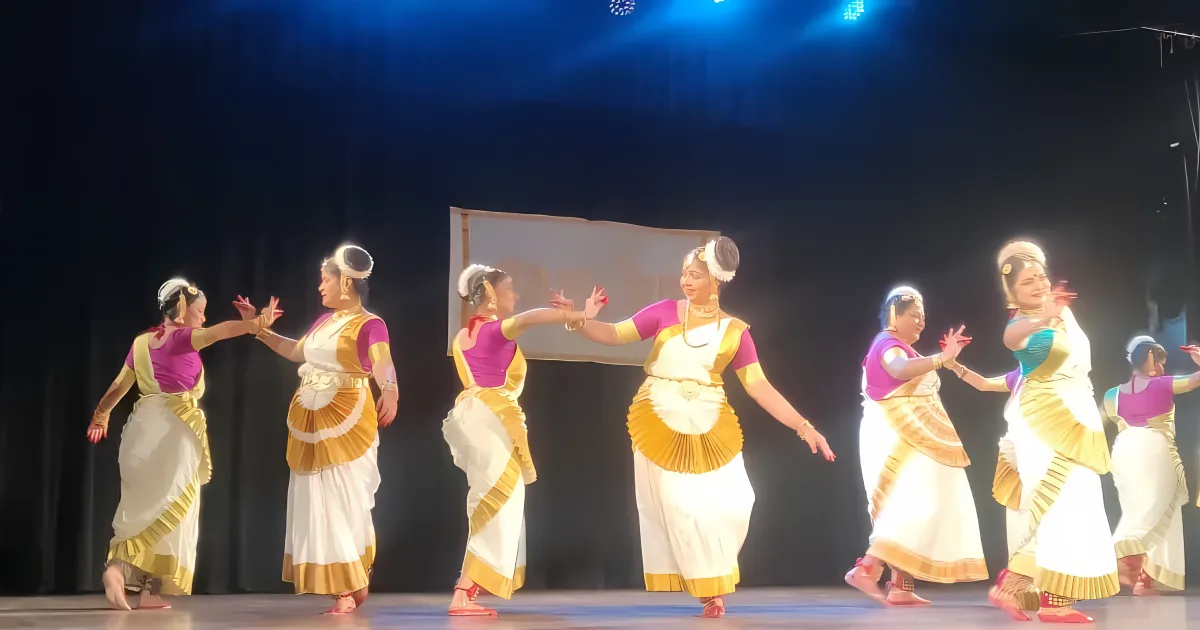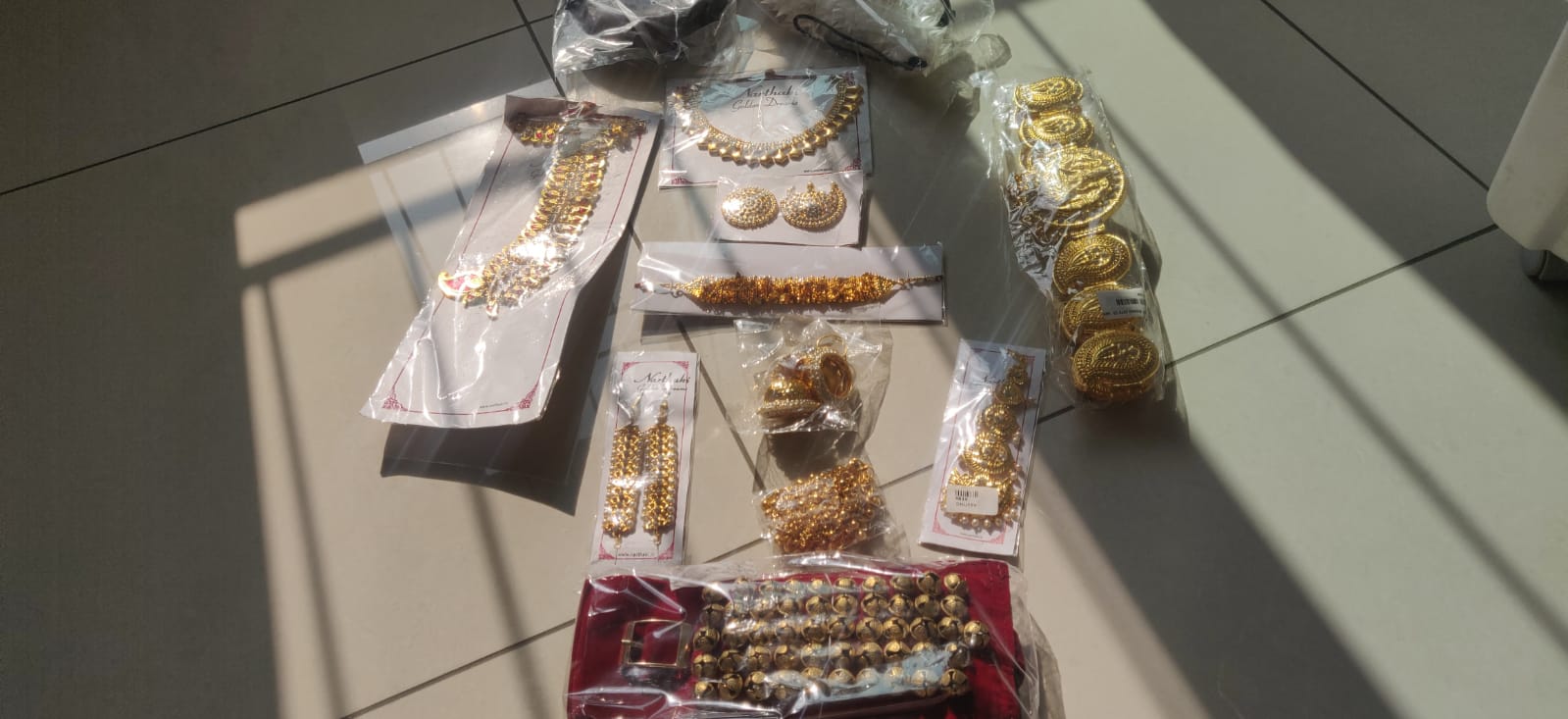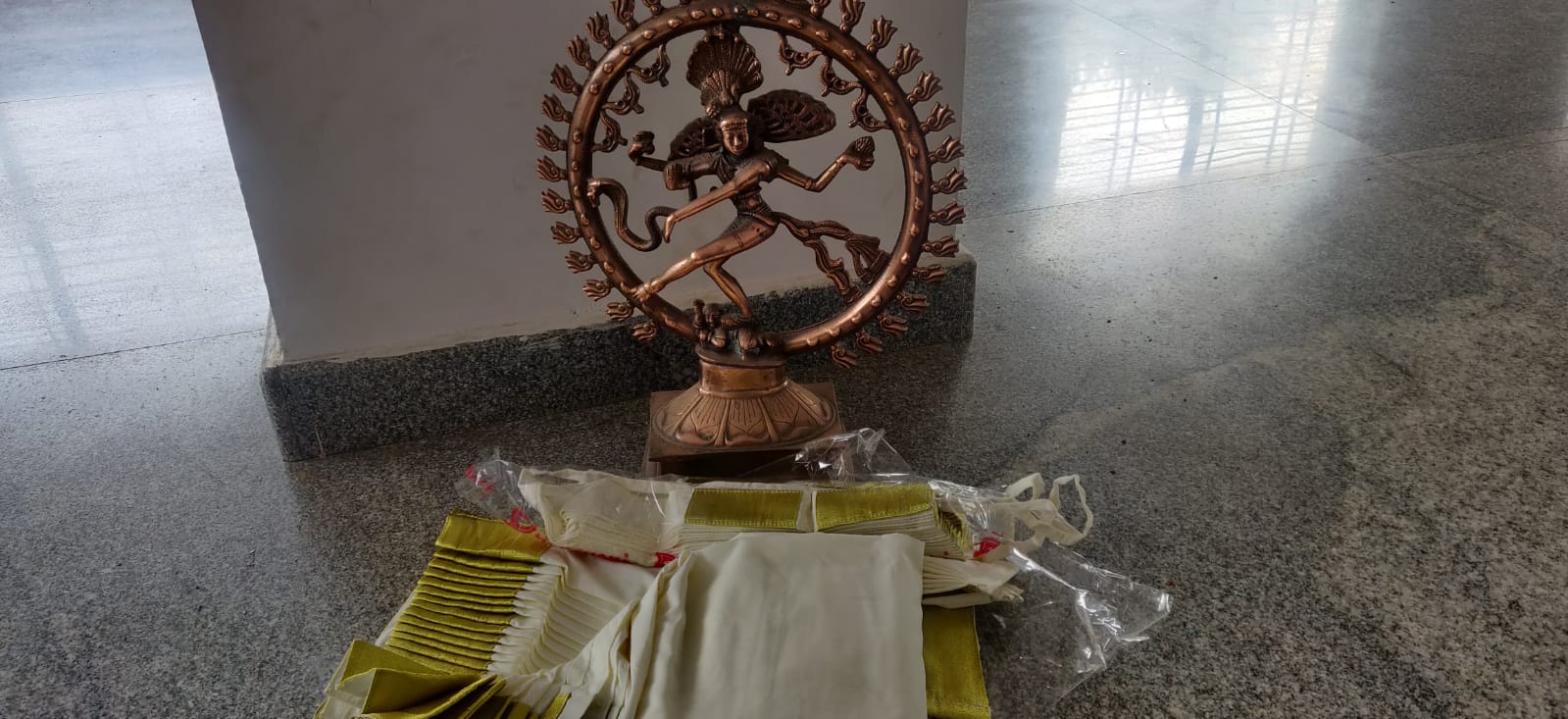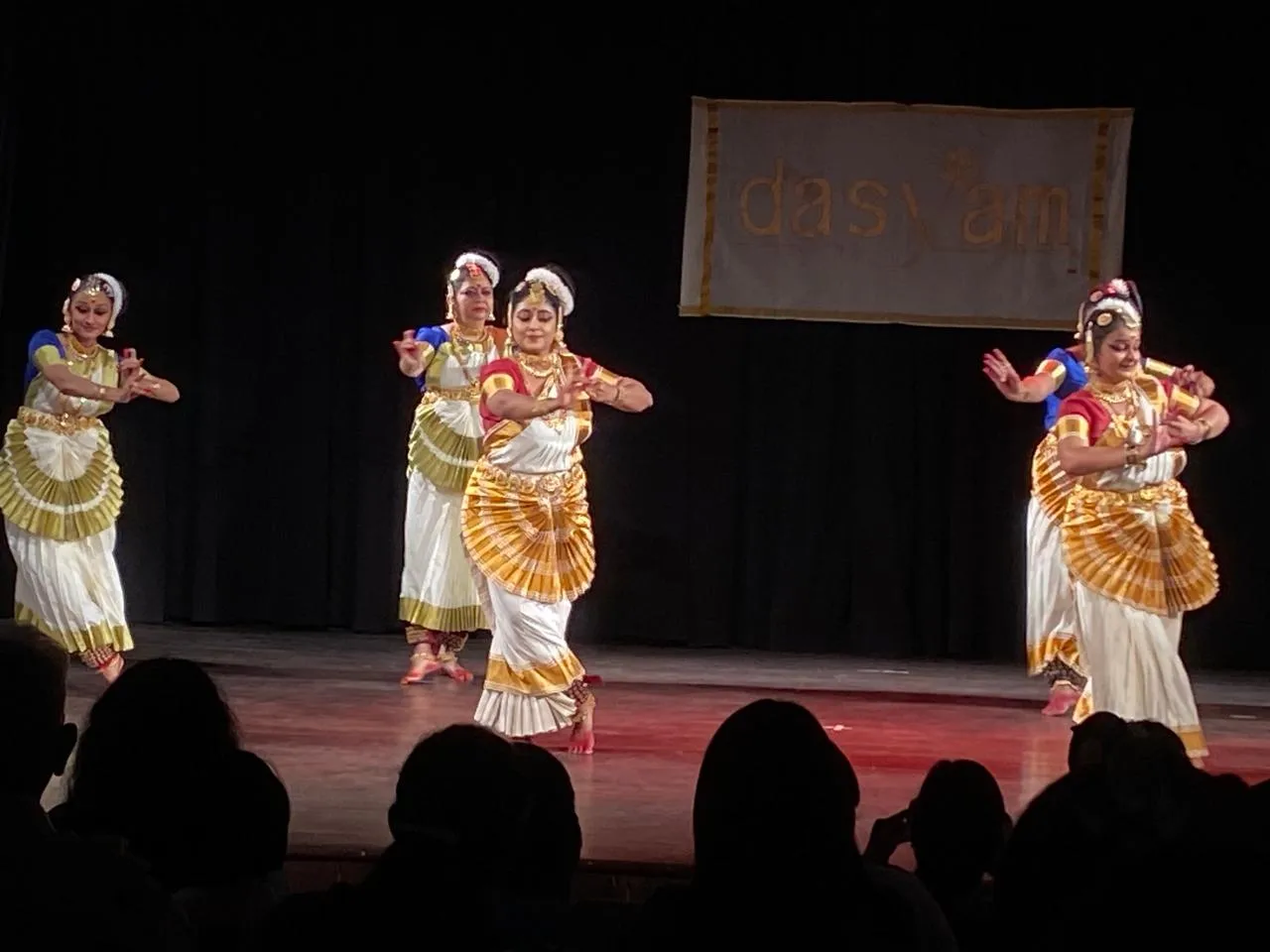
Magic in Mohiniyattam - IKS Pedagogy in Practice
16 March, 2024
2577 words
share this article

मन्दाकिनीसलिलचन्दनचर्चिताय नन्दीश्वरप्रमथनाथमहेश्वराय। मन्दारपुष्पबहुपुष्पसुपूजिताय तस्मै मकाराय नमः शिवाय॥
When this invitation went out it became official, we would now be performing on stage. I would be doing so after fourteen long years. Stage no longer held the magic it once did, what gave me impetus was the whole pedagogy in practice that is unique to our Indian Knowledge Systems. A teacher, a mentor, a guide and a friend who shows us how it is done and leads us all the way, making us teachers in the end. It is a self perpetuating system; this teacher-student relationship that is replete with respect, service, and organic transference of know-how. There is psychological and emotional well-being when it is practised right, and there is integrated development and awareness of one-ness when practised right for a dedicated period of time. Sacred texts suggest a minimum of twelve solid years for reaching a certain level of proficiency and skill before one can even think of making a mark in the world.
Art is elevating, Indian art more so. It is designed to connect us to the sacred by cleansing us of our internal impurities. It generates wonder and gratitude in its practitioners as much as in its viewers. When we watch and learn step by step, day-by-day, how to depict the stories of our land, our deities, and our beliefs, it transforms us from within, soothing our frayed nerves and providing succour in return. Who would want to miss that, having known its nectar from a young age! The attraction was in submission now, to the system, to the vision, to the commands from above. Turn here, move your hand like this, look there, smile, sit more, don’t shake so much… yes these seem like the barking orders of a military sergeant, but how different is a dance teacher from one! And look who they turn out at the end of training; like a military cadet on his passing out parade, a dancer on stage flies into the air with gay abandon in full control of each and every part and particle of her body.
Last year when I met Gopika chechi for writing on the Travancore Royals, The Saga Of The Padmanabhadasas Part 3, it struck me that Mohiniattam was well suited for all body types and any age group. It was with a lot of encouragement from her and the three non-Malayalees in the whole workshop that I finally decided to take this up; thank you Kanakavalli garu, Shraboni Ghosh, and Neha Rao. Via online classes, videos, and frantic WhatsApp calls over the past few weeks, one short item dedicated to Shiva was chosen, and then the choreography was deconstructed bit by bit and scaffolded so that we could climb the ladder and perform effortlessly. It is not just learning, but also learning how to teach that is taught by example, in all IKS streams.
The programme order was sent out for Jan 27th 2024 10.00am, and our item was the third one. Nagendra Haraya, the Shiva Panchakshari Stotram is well known, it made our task so much easier, since we did not have to learn fresh lyrics. Depicting mandakini salila chandana charchita… was one of my most favourite parts, Mohiniattam is a dance known for its lasya; it flows, it is feminine, and is graceful. Added to that we had to depict the river goddess Ganga in one section. There were times when I felt I was the river herself in her benign state, touching people’s hearts, a balm as cool as sandalwood. The excruciating body movement i.e., chuzhippu practice sessions paid off and I was able to move my torso as required. There would be thirty five students in all who would be participating in the annual day from all over the world.
Newbies like Shraboni and I had no costume or jewellry to speak of. Each dance style has its own distinct clothing and adornment. Odissi’s is all silver, Vilasini Natyam’s all wooden, Kuchipudi’s is all golden and so on. Kerala style chokers, necklaces, and big jhumkis beckoned us, as did gold anklets. We don’t wear gold on our feet in Bengal said Shraboni. True, only kshatriyas are supposed to wear gold on their feet as they are mahipalas, protectors of earth I replied in agreement. Perhaps this was to be expected since this dance form breathed its life due to Swati Thirunal, the great Travancore king and connoisseur.

I was going to be in Bengaluru for a Temple Conference, and also for Gudiya Sambhrama anyway, and Shraboni was gracious enough to host me. It is always wonderful to spend time with guru behens, and although we were supposed to practice the dance item leading upto the annual performance, we ended up doing everything else instead. We ordered our costume and jewellry sets together from Narthaki in Thiruvananthapuram. And when they arrived we requested Nataraja to bless them.

So now we had a costume but no blouse, so we went to a tailor that Sindhu ji our mentor recommended, as he was adept at stitching dance costumes and blouses. Mohiniyattam blouses are a bit different, they are a bit longer and choli-like.

We also rented a space in Yelahanka for practice where all six of us, who were together in this level, could meet for in person practice for two days before the event. We were all meeting for the first time to dance this item and it was very tiring, doing the same dance for hours on end.

The camaraderie of shared experience and shared goals is something all IKS practitioners appreciate.
As do military men! Solo dancing has its own scares, but group dance is all about team effort, coordination, and ‘matching’ with those in front. So as to make it look seamless, a lot of work goes on behind the scenes to appear spontaneous. All this had to be fine tuned in just two days. Although given our hectic lives, two days was also a luxury.


A dress rehearsal is always recommended, to check if everything fits and if the screws of earrings are in place. A lot of preparation time also went into tying threads to the head ornaments to make them ‘battle ready’ for the performance. To be prepared not just for the dance (in terms of remembering the choreography) but also for the overall performance (in terms of make-up, costume, hair) is taxing. It also keeps us on our toes and builds character. When the young go through this process regularly they learn discipline, teamwork, coordination, self-expression, kinesthetics, aesthetics, as well as humility. When the older take to training in classical dances, they are able to tap into the very joy of our being, which is the whole purpose of the Indian Knowledge Systems (IKS).

Now the hair is the most difficult aspect of the whole attire, especially for Mohiniyattam. All dancers of all styles know that make-up comes last when getting ready for one’s performance. Without doing one’s hair one cannot put on head pieces or even ear-rings, all of which sit on one’s hair. Growing up if one was learning dance, we had to grow our hair long, it was unthinkable for a dancer to sport short hair. Given the top knot I am expected to put on for Mohiniyattam (a distinct identity of the dance form), I wished my hair was shorter. It was quite a tough task to accommodate all my hair into that round bun before netting it for neatness. Finally, one puts on all the headgear along with the white garland, and also bangles, to then go and sit in front of the make-up man. Oh! I forgot to mention alta. It is the red liquid that one applies on hands and feet to exaggerate one’s mudras.

Seva Sadan has two dressing rooms with attached toilets. Usually fights and disagreements take root and fester in such places. Or everyone is haggling for the mirror or the make-up man. But here there was only goodwill and cooperation. This is a mark of great leadership. I noticed the same during the workshop last April too in Thiruvananthapuram. Everyone was simply smiling and assisting one another. This is very rare in the dance world. It ultimately rests on the top brass on how they lead and how they train their ‘young’. If the leader leads by example of affection, compassion, empathy and acknowledgement, this is what the juniors learn. My back room experience at Seva Sadan was one of the best. One beautiful lady I had just met and the compere for the show, Lakshmi, applied alta to my feet, another person Shreeja tied by waistband, yet another co-dancer Beena helped with putting on safety pins in the right place. Like a soldier with body armour who loses some agility due to the weight on him, we too were weighed down by the beauty of it all. We were asked to do stretches and sit ups before getting on stage so that our costume would not get in the way of our dancing.


All the groups as per seniority came one by one to take blessings from Gopika chechi and offer gurudakshina. She blessed all the chelangais, the ghungroos, the ankle bells. There was no prior intimation in the dance group that we needed to offer something to chechi, nor was the amount fixed, there was absolutely no pressure on the contents or the amount of gurudakshina either. Everyone watched one another and started rummaging in their purses. Thank god amma always insists that I carry some cash in case of emergencies. That helped. One cannot ask a guru for blessing the ankle bells empty handed, this is against traditional wisdom. And chechi here has been encouraging all of us to perform, get on stage, and dance. She has no qualms about pushing us into the limelight and taking a step back. Such is her generosity. A royal in every which way.
It was now time. Keerthi, who was part of our group, sang the invocation to Ganesha after the lighting of the lamp, and the program started off on an auspicious note. The audience consisted mainly of family and friends. It was an interesting experiment to sit in the audience and then to go backstage and witness the happenings there. In the front as an audience one is critical, judgmental, and appreciative, while behind the curtains each dancer is in a different zone, mentally repeating the choreography and practising. It is all a matter of perspective. One can learn a lot just by watching too.
Life is but a classroom for those who are ready.
All the groups performed well, ours could have done a lot better if we had met a few more times in person. There is a lot to be said for in person classes. Although all of us benefit from online versions, which saves time, money, and energy. What our in-person interactions gave in two days was impossible to garner in two months. Also it is all about practice. The longer we practise, for longer hours, the better we will be. This is the only formula. Hard work starts to make sense all of a sudden. There are no shortcuts. The body has to be seeped in these steps, these expressions, these hand gestures. It cannot fake it to a live audience.


As you can notice from above, we were far from perfect, and needed more coordination. But we had made a commitment and we had made a beginning. Taking up any of the Indian Knowledge Systems is not simple.
Well, taking up is simple, seeing it through is arduous. To find the mental frame of mind to attend classes, the physical time to allocate for practice, to keep oneself engaged with the teachers and co-students even if we do not get along personally, to enjoy the whole process of learning dance and dancing on stage despite the daily rigor, this needs self motivated individuals who are passionate about such systems. One has to be in love with beauty and aesthetics to want to offer it to a world which is more often than not strife ridden. To be a balm to that nagging pain is the job of a dancer or any other artiste.

Thoughtful as she is, Gopika chechi had a certificate ready for all participants. What mattered to me was not that as much as the whole experience of being immersed in this dance form and growing in it, making its language my own, performing some aspect of it, internalizing it as much as I could. Chechi asked me to dance as much as possible and to continue my learning and to not let go. I think there is a lot of merit in being a learner at this age. It keeps me meaningfully occupied, not letting me waste my time in petty thoughts or gossip, it gives me a break from monotony, from routine work or social dealings and transactions. It gives me and others pursuing it a cause to celebrate, something to look forward to, to don the roles of our deities and embody them, and above all it brings beauty in line with dharma to society.

पञ्चाक्षरमिदं पुण्यं यः पठेच्छिवसंनिधौ। शिवलोकमावाप्नोति शिवेन सह मोदते॥
We then went on to celebrate at the Brahmin Cafe on my friend Kopal’s recommendation (someone I had met just a month before at the Mysuru Yoga Utsava), none of us Bengaluru natives. It was an extension of our experience at Seva Sadan. This place is so simple yet the food is so delicious, no frills yet it delivers Shraboni said with surprise. It is a poetic ending to our Annual Day project, which was also no frills, yet completely rooted I added, in wonder and gratitude.